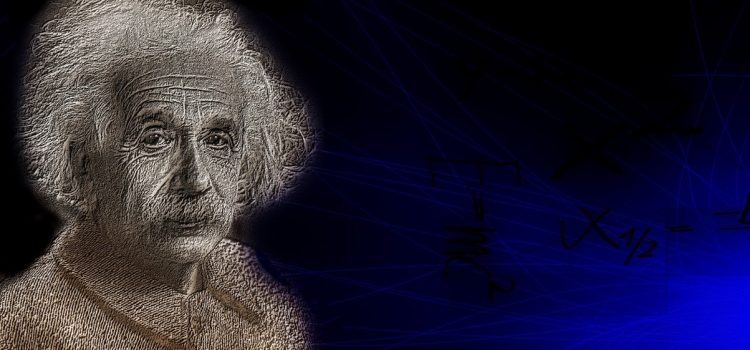

This article is an excerpt from the Shortform book guide to "The God Equation" by Michio Kaku. Shortform has the world's best summaries and analyses of books you should be reading.
Like this article? Sign up for a free trial here.
What problems of science did Einstein solve? How did he push the quest for a unified theory forward?
For centuries, scientists have looked for a single theory that would unify different fields of science, providing one equation that gives us a complete understanding of the universe. In The God Equation, theoretical physicist Michio Kaku discusses Albert Einstein’s contributions to the quest.
Continue reading to learn about Einstein and unified theory.
Before Einstein
Before Albert Einstein, unified theory was advanced by the work of Isaac Newton and James Clerk Maxwell. Let’s take a look at what Einstein built upon.
From 1666 to 1687, Isaac Newton worked out the first mathematical theory to explain the laws governing the motion of objects, as well as the “law of universal gravitation” that explained both how objects fall to Earth and how the planets orbit around the sun. Kaku says this was a breakthrough moment in science because Newton had shown through hard, solid math that celestial objects followed the same laws of motion as everyday objects in the world of human experience. Prior to Newton, religious leaders and philosophers had always considered the skies above to be separate from the Earth. But Newton’s mathematics, once confirmed by observation, proved that the two were the same.
(Shortform note: Newton’s revelations did more than set physics on the path toward a unified theory, as Kaku suggests. Newton’s mathematical approach constituted a whole new paradigm for scientific thought. In The Structure of Scientific Revolutions, Thomas Kuhn defines a scientific paradigm as an idea that serves as a framework for a whole field of scientific inquiry. Newton’s laws are often seen as part of the shift from an Earth-centered model of the universe to one in which the planets revolve around the sun, but Newton’s discoveries went deeper than that. In Cosmos, Carl Sagan explains that Newton’s most important contribution to science was to show that the fundamental rules of nature can be expressed as mathematical laws.)
In 1861, James Clerk Maxwell expressed the relationship between electricity and magnetism in mathematical form. When he did, his equations revealed that the back-and-forth between electrical and magnetic fields, in which one creates the other and vice versa, propagates at a constant speed—the speed of light! Out of the blue, Maxwell had discovered that light is a wave in the electromagnetic field. Not only that, but his equations predicted frequencies of light beyond what we can see—the entire invisible electromagnetic spectrum that astronomers now use to explore the depths of space.
Einstein & Unified Theory
Thanks to Newton’s and Maxwell’s equations, physicists at the start of the 20th century believed there wasn’t much left to explore. But, Kaku points out that there was a problem: Under certain conditions, Newton’s and Maxwell’s theories were incompatible with each other. After explaining the nature of the problem, we’ll discuss how Albert Einstein solved it by reimagining Newton’s laws of motion and then rewriting Newton’s law of gravitation.
The contradictions between Newton’s and Maxwell’s laws appear when you consider objects moving near the speed of light. Suppose a cat is chasing a laser pointer at 600 million miles per hour. The beam of light from the laser pointer passes the cat at 671 million miles per hour. How fast would the beam of light appear from the cat’s point of view? Newton says that speeds add and subtract—the cat would see the laser beam moving at only 71 million miles per hour. However, Maxwell’s equations suggest that the speed of light never changes. No matter how fast the cat is chasing the pointer, it will always perceive the ray of light to be moving at 671 million miles per hour. Both answers can’t be true, so either Newton or Maxwell was wrong.
(Shortform note: Though Kaku doesn’t address it, physicists knew that it was Newton who was wrong because of an experiment conducted in 1887 by Albert Michelson and Edward Morley. At the time, scientists believed that electromagnetic waves such as light propagated through an invisible medium known as aether and that light’s observed speed would vary under the rules of Newtonian physics. Michelson and Morley designed an experiment to measure the difference in the speed of light parallel and perpendicular to the Earth’s motion through the aether. The experiment showed no difference at all—the speed of light went unchanged regardless of the speed and direction of the observer, disproving the “aether theory” of how light travels.)
Special Relativity
Kaku writes that Einstein proposed a radical solution to the problem. For the speed of light to remain a fixed constant no matter how fast an observer is moving, space and time have to distort so the speed of light remains the same. This is the basis of Einstein’s theory of special relativity. In Einstein’s new equations governing objects in motion, Newton’s laws still apply if your speed is relatively slow, but as you accelerate, time slows down, space contracts, and the speed of light that you observe remains unchanged.
(Shortform note: Physicists at the time were reluctant to accept Einstein’s theory, though Kaku doesn’t elaborate on the era’s disputes. At first, Einstein’s theory slowly gained acceptance within Germany, while scientists in the US and Britain clung to the aether model, considering Einstein’s work to either be ridiculous or too hard to understand. Einstein’s theories were more widely accepted by the 1920s after his expanded theory of general relativity—which we’ll cover next—was confirmed via astronomical observations in 1919.)
Einstein’s equations also add additional layers of symmetry to Newton’s. The first is that, in relativity, you can substitute time for any direction in space. In other words, relativity is symmetrical in four dimensions, not just three. The second symmetry is similar to when Faraday showed that electricity and magnetism are interchangeable. In this case, Einstein revealed that energy and matter are equivalent to each other via his famous equation E=mc2 (energy equals mass times the speed of light squared). Therefore, says Kaku, special relativity unites energy and matter, as well as time and space.
| The Cosmic Speed Limit Because mass and energy are interchangeable, what happens when you approach the speed of light is even stranger than Kaku suggests. In A Brief History of Time, Stephen Hawking explains that as objects accelerate, gaining energy, they gain additional mass as well. At the relatively slow “Newtonian” speeds we experience in our everyday world, this effect is so tiny as to be immeasurable, but if you were to accelerate a spacecraft to a significant fraction of the speed of light, the spacecraft’s mass would noticeably increase. In fact, as an object gets to the speed of light, its mass increases exponentially, requiring even more energy to accelerate it further. An object moving at the speed of light would have infinite mass, which would require an infinite amount of energy to propel it at that velocity. Hence, the speed of light is the cosmic speed limit—there isn’t enough energy in the universe to accelerate an object to lightspeed. |
General Relativity
Nevertheless, Einstein knew his theory was incomplete. It corrected Newton’s laws of motion but said nothing about the law of gravitation. According to Newton, the effects of gravity are instantaneous—if a source of gravity suddenly moves, the change in its force is immediately felt—but that contradicts the rule that nothing can travel faster than light, as established by Maxwell and Einstein. Kaku states that this was the next vital step in unifying physics—to combine Einstein’s theory of special relativity with Newton’s theory of universal gravitation.
Einstein’s solution was to propose that the force of gravity is actually an illusion caused by the deformation of space. Consider a marble rolling across a trampoline. If the trampoline is flat, the marble rolls straight across, but if there’s a bowling ball sitting in the middle, pulling the fabric of the trampoline down, the marble will appear to be “attracted” to the ball, no matter which way it was originally rolling. This is the essence of Einstein’s theory of general relativity, which shows that matter warps space around it—the greater the mass, the greater the “dent” it makes. Kaku lists ways that Einstein’s equations reveal things that Newton’s can’t—such as predicting how gravity causes light to bend or explaining the planet Mercury’s erratic orbit.
(Shortform note: Kaku also mentions gravitational waves in the fabric of space, which Einstein predicted but which weren’t observed until 100 years later, once again solidifying the theory of relativity. However, since the time of Kaku’s writing, even more discoveries have been made in this field. In 2023, astronomers used observations of pulsars—the rapidly rotating cores of dead stars—as a way to observe gravity waves on a galactic scale. By measuring minute variations in different pulsars’ rates of rotation, in 2023 astronomers discovered a universal hum of gravity waves caused by the merger of supermassive black holes. These titanic astronomical events may yield clues to how the universe has developed in the billions of years since the Big Bang.)
Exercise: Reflect on Theories
The implications of Einstein’s relativity—that time and space can stretch and bend—have been verified by experiments for over 100 years. When such seemingly implausible theories are confirmed by experiments, does it make it easier for you to accept it as fact, even if you don’t understand the math behind it? Why or why not?

———End of Preview———
Like what you just read? Read the rest of the world's best book summary and analysis of Michio Kaku's "The God Equation" at Shortform.
Here's what you'll find in our full The God Equation summary:
- The search for one theory that would unify all the rules of physics
- Why physicist Michio Kaku thinks string theory may hold the answer
- An explanation of string theory and the underlying symmetries of nature






